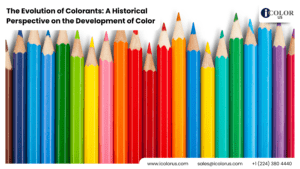Introduction
Science of Colorants and Pigments – Colors enrich our lives in ways we often take for granted. From the vibrant red of a ripe tomato to the calming blue of the sky, colors influence our emotions, behaviors, and choices. But have you ever wondered what makes these colors so vivid and appealing? The answer lies in the fascinating world of colorants and pigments. This article delves into the science behind these essential substances, exploring their types, applications, and the industry trends driving their evolution.
The Basics Science of Colorants and Pigments
Colorants and pigments are substances used to impart color to materials. While they are often used interchangeably, there are distinct differences between the two:
- Colorants: These are substances that impart color to a material and can be either soluble (dyes) or insoluble (pigments). Dyes dissolve in their medium and bind chemically to the material they color.
- Pigments: Pigments are insoluble particles that impart color by scattering light. They do not dissolve but instead remain suspended within the medium, providing color through reflection and absorption of light.
Types of Pigments
Pigments can be broadly categorized into organic and inorganic types:
- Organic Pigments: Derived from natural sources or synthesized chemically, these pigments are known for their bright, vivid colors. Common examples include phthalocyanine blue and quinacridone red. They are widely used in industries such as textiles, plastics, and cosmetics.
- Inorganic Pigments: These are derived from minerals and metals and are known for their durability and opacity. Examples include titanium dioxide, iron oxide, and chromium oxide. Inorganic pigments are extensively used in paints, coatings, and construction materials.
The Science Behind Pigments
The color of a pigment is determined by the wavelengths of light it absorbs and reflects. This phenomenon is rooted in the pigment’s molecular structure, which dictates its interaction with light. For instance, a pigment that absorbs most wavelengths except those in the red spectrum will appear red to the human eye.
Absorption and Reflection
When light strikes a pigment particle, certain wavelengths are absorbed while others are reflected. The reflected light is what we perceive as color. For example, chlorophyll, the pigment responsible for the green color in plants, absorbs red and blue wavelengths and reflects green.
Particle Size
The size of pigment particles also plays a crucial role in color perception. Smaller particles tend to scatter light more efficiently, leading to brighter, more intense colors. Conversely, larger particles result in duller, more muted hues.
Applications of Colorants and Pigments
Colorants and pigments are integral to a wide range of industries, each requiring specific properties to meet their unique needs:
Food and Beverage
In the food industry, colorants are used to enhance the visual appeal of products. Natural colorants such as carotenoids (orange-red hues) and anthocyanins (red, purple, and blue hues) are popular choices. The global market for natural food colorants was valued at USD 1.6 billion in 2020 and is projected to grow, driven by consumer demand for clean-label products.
Cosmetics
The cosmetics industry relies heavily on pigments to create a variety of products, from lipsticks and eyeshadows to foundations and nail polishes. Organic pigments are favored for their vibrant colors, while inorganic pigments provide stability and opacity.
Paints and Coatings
In the paints and coatings industry, pigments are used to provide color, opacity, and durability. Titanium dioxide, a white pigment, is the most widely used due to its excellent covering power and brightness. The global market for pigments in this sector was estimated at USD 28.6 billion in 2021, with continued growth expected.
Textiles
Textile manufacturers use dyes and pigments to color fabrics. Pigments are often preferred for their ability to produce consistent, long-lasting colors that can withstand washing and exposure to sunlight.
Innovations in Pigment Technology
The field of pigment technology is constantly evolving, driven by advancements in materials science and growing environmental concerns. Key trends include:
Sustainable Pigments
There is a growing demand for sustainable and eco-friendly pigments. This has led to the development of pigments derived from renewable sources and the reduction of harmful chemicals in pigment production. For example, some companies are exploring the use of algae and bacteria to produce bio-based pigments.
Nanotechnology
Nanotechnology is playing a significant role in pigment innovation. Nanopigments, which have particles smaller than 100 nanometers, offer superior color strength and transparency. They are increasingly used in applications requiring high performance, such as automotive coatings and high-end cosmetics.
Functional Pigments
Functional pigments are designed to provide additional benefits beyond color. Examples include UV-resistant pigments, which protect materials from sun damage, and thermochromic pigments, which change color with temperature variations. These advanced pigments are finding applications in smart textiles, packaging, and safety gear.
The Importance of High-Quality Pigments
The quality of pigments directly impacts the performance and aesthetics of the final product. High-quality pigments offer several advantages:
Consistency
Premium pigments provide consistent color, ensuring that each batch of the final product meets the same standards. This is crucial for industries such as automotive and fashion, where color accuracy is paramount.
Stability
High-quality pigments are more stable, maintaining their color and properties over time. This stability is essential for products exposed to environmental factors, such as sunlight and moisture.
Safety
Top-tier pigments are free from harmful contaminants, making them safer for consumers and the environment. This is particularly important in the food, beverage, and cosmetics industries, where product safety is non-negotiable.
iCOLOR US LLC: Leading the Way in Pigment Solutions
At iCOLOR US LLC, we specialize in providing high-quality pigments and colorants to meet the diverse needs of various industries. Our commitment to excellence and innovation ensures that our clients receive the best possible products and services.
Comprehensive Product Range
We offer a wide range of pigments and colorants, including organic, inorganic, and specialty pigments. Our products are designed to deliver superior performance, whether you need vibrant colors for cosmetics or durable pigments for industrial applications.
Expertise and Support
Our team of experts is dedicated to helping clients find the right pigment solutions for their specific needs. We provide technical support, color matching services, and custom formulations to ensure optimal results.
Sustainability
At iCOLOR US LLC, we are committed to sustainability. We continuously seek ways to reduce our environmental impact, from sourcing eco-friendly raw materials to implementing green manufacturing practices.
Conclusion
Understanding the science of colorants and pigments is essential for appreciating their role in various industries. From enhancing the visual appeal of food to providing durability in coatings, pigments are indispensable. As the demand for high-quality, sustainable pigments grows, companies like iCOLOR US LLC are leading the way in innovation and excellence.





